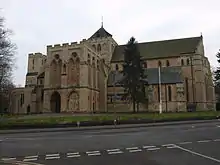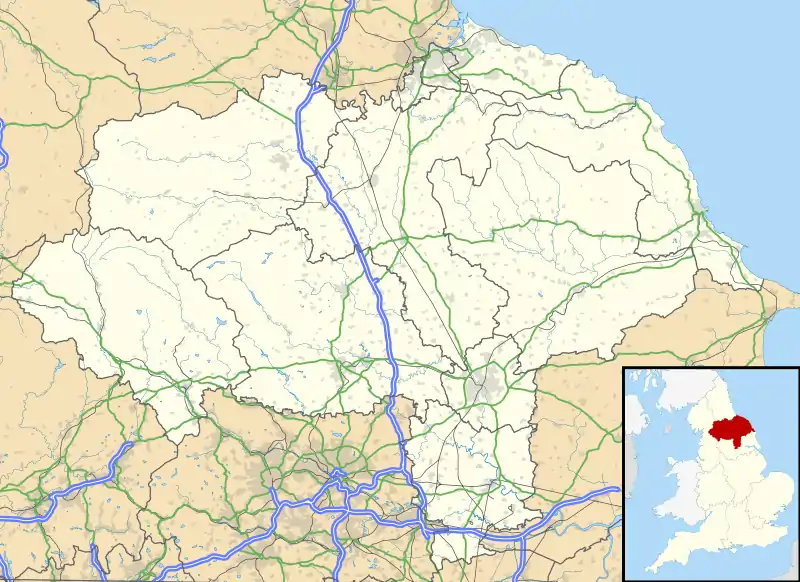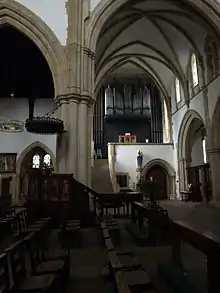St Wilfrid's Church, Harrogate
St Wilfrid's Church, Harrogate is an Anglican parish church in the town of Harrogate, North Yorkshire, England. It is a Grade I listed building, the only such building in Harrogate. It was designed by the architect Temple Lushington Moore and is his most famous work. It is designated as a "Major Parish Church" and is the 38th largest parish church in England.
| St Wilfrid's Church | |
|---|---|
 | |
 St Wilfrid's Church | |
| Denomination | Church of England |
| Churchmanship | Traditional Catholic |
| Website | www.stwilfrid.org |
| History | |
| Status | Active |
| Dedication | St Wilfrid of Ripon |
| Architecture | |
| Functional status | Parish church |
| Heritage designation | Grade I listed |
| Designated | 4 February 1975 |
| Architect(s) | Temple Moore |
| Years built | 1904– |
| Administration | |
| Parish | St. Wilfrid, Harrogate |
| Deanery | Harrogate |
| Archdeaconry | Archdeaconry of Richmond and Craven |
| Episcopal area | Ripon |
| Diocese | Diocese of Leeds |
| Province | Province of York |
| Clergy | |
| Bishop(s) | The Rt Revd Tony Robinson (AEO) |
| Rector | Fr Gary Waddington SSC |
| Honorary priest(s) | Fr Tim Burrell
Fr Gavin Gilchrist Fr Terry Buckingham |
| Laity | |
| Director of music | Anthony Gray |
| Churchwarden(s) | Andrew Haslam and Christine Turner |
History

The construction of the church started in 1904 following a bequest of £3,485 from the estate of the late Bishop of Ripon to the Ecclesiastical Commissioners.[1] This allocation was instrumental in procuring an Order in Council on 12 August 1904[2] for the formation of the new district of St Wilfrid, Harrogate. The church was estimated to cost around £24,000.
The Bishop of Knaresborough dedicated the Nave and Baptistry on 4 January 1908[3] which had consumed £11,000.
Two sisters, Elizabeth Sophia and Jean Trotter gave large donations to fund the completion. The first gift of £10,000 (equivalent to £966,759 in 2019),[4] allowed the nave to be completed by 1914. The church was consecrated on Thursday 11 June 1914 by the Bishop of Ripon[5] at which point the initial estimated cost of £24,000 had already been spent. The church had to be guarded all night by a band of church workers to prevent it being the object of attention on the part of militant Suffragettes.
Temple Moore died in 1920 and a bequest from Jean Trotter in 1924 of £32,000 (equivalent to £1,838,562 in 2019),[4] allowed the completion of the north and south transepts. The work was completed in 1927 by Temple Moore's son-in-law, Leslie Moore. In 1928, the organ was installed in the North Transepts. The organ and transepts were dedicated by the Bishop of Oxford on 18 July 1928.[6]
William Gunn left £9,000 (equivalent to £629,362 in 2019),[4] in his will of 1932 and this allowed the church hall to be built. The hall features a lamella roof, the only example of such a construction in the United Kingdom.
In 1935, the generosity of Sir William Nicholson allowed the Lady Chapel to be built by William Nicholson and Son of Leeds at a cost of £10,000 {equivalent to £699,300 in 2019).[4] The Calvary was the work of Alfred Southwick.[7] While most of the work after Temple Moore's death in 1920 had been sympathetic to his sketches, Leslie Moore's design for the Lady Chapel was radically different from the small chapel proposed by this father-in-law.
Reception
The church is widely considered to be Temple Moore's greatest work. It subtly dominates the Harrogate skyline, and Pevsner considers it to be "the biggest and by far the best of Harrogate's churches, the masterwork of Temple Moore". Sir Aston Webb highlights its national importance, and goes as far as to say it is "perhaps the most beautiful of all parish churches I know" (Yorkshire Post, 8 June 1935). The church is subject of Sir John Betjeman's poem "Perp. Revival i' the North", in which its elegant grandeur and traditional liturgy are identified. Elsewhere, he remarks how the building seems vast in every direction, enhanced by what he describes as "Edwardian vistas".
Leslie Moore's faithful completion of his father-in-law's masterpiece is a great credit to him. His skill as an architect is further credited by the Church Times for February 24, 1950, which writes "Mr Leslie Moore has outdone his uncle by adding the loveliest part of the building - the Lady Chapel". In a local newspaper, reviewing the dedication of the Lady Chapel, it was described as a "glorious pageant in Christian architecture".
On 4 February 1975, St Wilfrid's Church was designated a Grade I listed building.[8]
Music
Musicians
Since the dedication of the building, there has been an uninterrupted choral tradition in the parish. A Music Foundation was established in 2015 to enhance the musical life of the parish, and improve the musical facilities available.
Former Directors of Music and organists include David Halls, now of Salisbury Cathedral, James McDonald, now of St Giles Pontefract, Leonard Sandermann and Simon Lindley. The current Director of Music is Anthony Gray, formerly of Southwell Minster and Robinson College, Cambridge.
Organ

The Harrison and Harrison organ in the North Transept was installed in 1928 upon completion of this part of the church. Its outline form is based on a 1912 sketch by Temple Moore, with minor alterations by Leslie Moore and Harry Harrison. Due to a lack of funds, no case proper was realised. The instrument was voiced by Arthur Harrison, and is one of the best preserved examples of his work. As such, the organ received Grade II*-listing from the British Institute of Organ Studies.
Due to lack of funds, eight stops, three chests, and one reservoir were not installed in 1928. Generations since have displayed a continuous commitment to the completion of the organ, with additions (mostly sympathetic) in 1942, 1968, 1972, 1982, and 2011. A restoration project is currently in the consultation phase.
Bells
St Wilfrid's Church has eight bells, for change-ringing, in the central tower. The heaviest six bells, cast from redundant bells from High Hoyland, were installed in 1973. The [tenor] of the peal weighs 6cwt and 3lbs and is tuned to C. In 1976 two redundant bells were obtained and the ring was increased to eight in 1977.
Additionally there is a Sanctus bell in the South-East tower.
Incumbents
|
|
See also
References
| Wikimedia Commons has media related to St Wilfrid's, Harrogate. |
- "Church building in the Ripon Diocese". Yorkshire Post and Leeds Intelligencer. England. 19 February 1914. Retrieved 16 September 2020 – via British Newspaper Archive.
- "No. 27704". The London Gazette. 12 August 1904. p. 5200.
- "New Church at Harrogate". Yorkshire Post and Leeds Intelligencer. England. 6 January 1908. Retrieved 16 September 2020 – via British Newspaper Archive.
- UK Retail Price Index inflation figures are based on data from Clark, Gregory (2017). "The Annual RPI and Average Earnings for Britain, 1209 to Present (New Series)". MeasuringWorth. Retrieved 2 February 2020.
- "New Harrogate Church". Leeds Mercury. England. 12 June 1914. Retrieved 16 September 2020 – via British Newspaper Archive.
- "Harrogate's New Church". Leeds Mercury. England. 17 July 1928. Retrieved 16 September 2020 – via British Newspaper Archive.
- "New Lady Chapel at Harrogate Church". Leeds Mercury. England. 8 June 1935. Retrieved 16 September 2020 – via British Newspaper Archive.
- "Church of St Wilfrid, Harrogate". British Listed Buildings. Retrieved 19 December 2016.
- The Story of St Wilfrid's church, Harrogate. Third Edition. c. 1950s
- The Parish Church of St Wilfrid, Harrogate. c. 1990s
- Specification of the organ